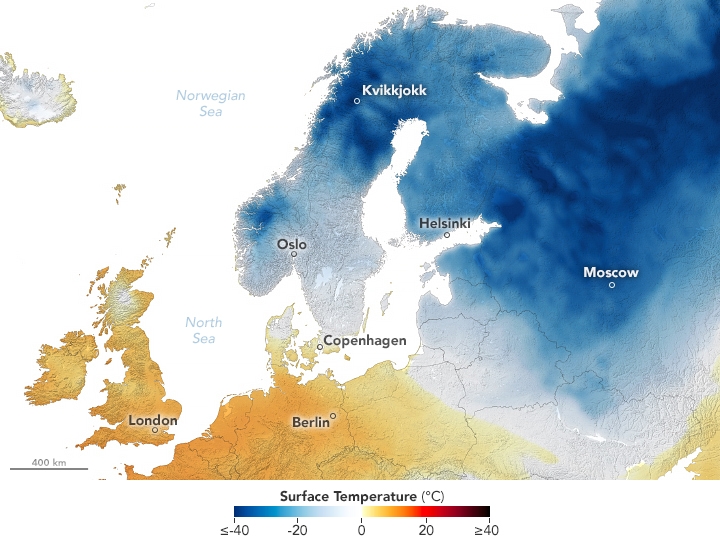Gepubliceerd op 4 januari 2024
In the northern Swedish village of Kvikkjokk, air temperatures plummeted to -43.6 degrees Celsius (-46.5 degrees Fahrenheit) on January 3, 2024. It marked the coldest January temperature recorded in Sweden in 25 years, according to news reports.
The extreme temperature comes amid a deep freeze that gripped Scandinavian countries in early January 2024. The extent and intensity of the cold snap is displayed in this map of modeled land surface temperatures—a reflection of how hot or cold a surface would feel to the touch—from 4 a.m. local time in Sweden (03:00 Universal Time) on January 3. It was produced by combining satellite observations with temperatures calculated by the Goddard Earth Observing System (GEOS) global model.

In addition to the extreme cold in the far northern reaches, temperatures were decidedly frigid in larger population centers to the south. Air temperatures, as measured by ground-based instruments, dropped to about -20°C (-4°F) in the Finnish capital city Helsinki. The Arctic air extended into western Russia, where it reportedly reached -30°C (-22°F) in Moscow, which is well below the average January low temperature of -12°C (10°F).
Heavy snow accumulation and high winds accompanied the biting cold, according to news reports, snarling travel, causing power outages, and forcing school closures. Hundreds of cars became stuck overnight on highways in Sweden and Denmark amid treacherous conditions; off-road military vehicles provided aid to stranded motorists in Sweden on January 4. Snowfall shut down train lines, and strong winds delayed a ferry carrying approximately 900 passengers from docking in Copenhagen, Denmark.
The hazardous weather arrived in Scandinavia as the U.K. was coping with rain and wind brought by Storm Henk, and as France and Germany were experiencing widespread flooding.
Source:
NASA Earth Observatory. (2024, January 3). Extreme Nordic cold.